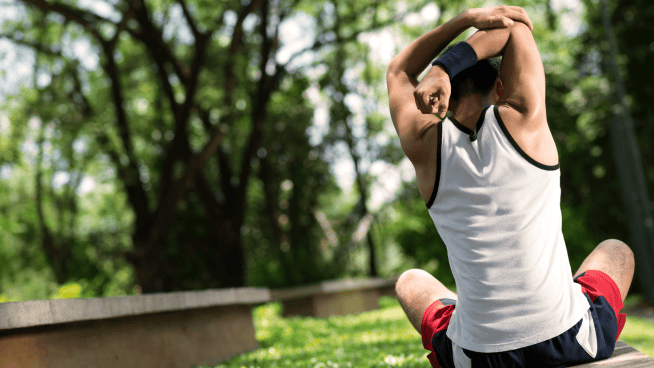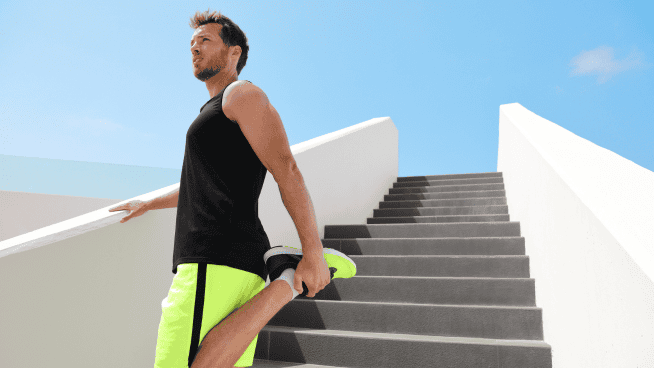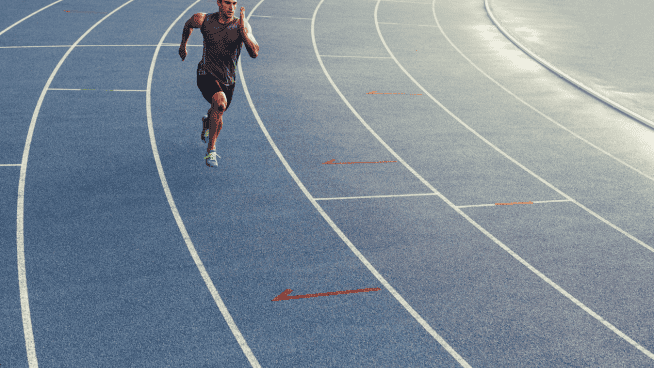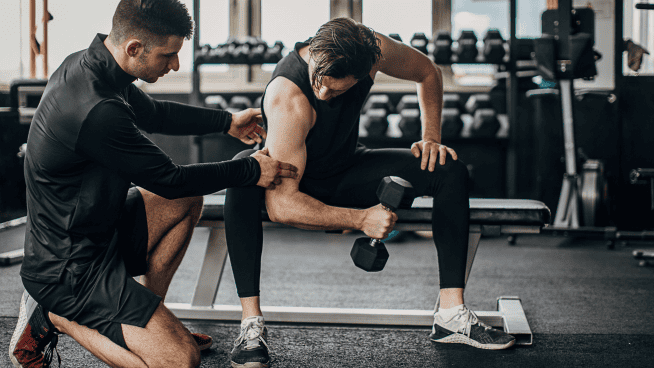Why You Should Ditch Your Alternate Grip Deadlift
The Deadlift is one of the greatest expressions of strength a human being can display.
The Deadlift is an exercise that can help all other exercises. No matter what your fitness goals may be, odds are the Deadlift can help get you there.
Since the act is a crux of their sport, powerlifters can deadlift incredible amounts of weight.
Many powerlifters utilize an alternate grip on the barbell to help them accomplish this.
An alternate grip simply refers to having one palm facing toward you (in a pronated/overhand grip) and one palm facing away from you (in a supinated/underhand grip) when you grab the barbell.
The grip’s ubiquity in powerlifting has helped it catch on with many deadlift practitioners outside the sport.
If many of the strongest deadlifters in the world use it, it’s gotta be good, right?
Maybe not.
I strongly believe that for those outside the sport of powerlifting, an alternate grip risks your health and limits your potential for gains. I contend that deadlifting with an alternate grip is one of the worst decisions you can make in your training.
Why I Dislike Alternate Grip Deadlifts
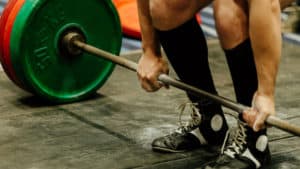
I have three issues with non-powerlifting athletes using an alternate grip to Deadlift: injury risk, training adaptations and return on investment.
Let’s be honest here: The only reason anyone uses an alternate grip during a Deadlift is to LIFT MORE WEIGHT. That’s it.
You might be thinking, “Isn’t that the point?”
Well, it is in powerlifting, but again, this isn’t about powerlifters. This is about athletes whose sport doesn’t center solely around lifting a barbell loaded with as much weight as possible.
The reason the alternate grip allows you to lift more weight is because the alternating pressure on the barbell makes grip strength less of an issue.
RELATED: The Deadlift Grip Guide: How Hand Placement Changes the Exercise
But by using a supinated (underhand) grip under such heavy load, this places a large stress on the biceps muscle group, especially the long head, which crosses at the gleno-humeral joint. This creates a high risk of injury, and it’s why biceps tears/pain are common among powerlifters.
For many people, the Deadlift is the barbell exercise that allows them to use the most weight. At some point, the biceps group will not be able to handle such intense loads. Maybe you’ll be just fine, but it’s a risk I don’t feel comfortable encouraging athletes to take.
Additionally, an alternate grip may make holding onto the bar itself easier, but aside from that, it introduces some asymmetries into the movement that can make it less beneficial.
For example, the lat on the overhand side is generally going to be in a stronger position than the one on the underhand side, which isn’t ideal from a stabilization standpoint. Your lats are key to creating tension and preventing your upper back from rounding during the movement, so having one “on” and one “off” can contribute to a crooked, inefficient lift.
These downsides are exacerbated by most people rarely mixing up their alternate grip—the same hand is always pronated, and the same hand (usually on their stronger side) is always supinated.
The Clean Grip Deadlift
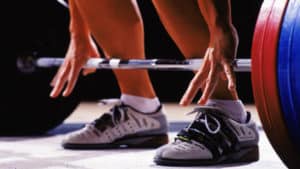
I prefer a Clean Grip Deadlift, which puts both hands on the barbell in an overhand (pronated) position slightly wider than shoulder-width apart.
A Clean Grip Deadlift is more challenging than an Alternate Grip Deadlift, mainly because it requires greater grip strength. Most people will not be able to Clean Grip Deadlift as much as they can Alternate Grip Deadlift for this reason.
However, I see this as a positive.
Grip strength is directly correlated to rotator cuff strength (Horsley et al, 2016). It is important to train the grip, and the Deadlift is one of, if not the, best strategies to do so. Also, the double overhand (clean) grip places a larger demand on scapular retraction than an alternate grip. It can also help keep the barbell closer to your body during the lift.
The common argument I hear from coaches who advocate for an alternate grip is that their athletes’ grips cannot handle the heavier loads their posterior chain needs for adaptation.
I completely agree.
This is why I believe that when things get heavy, lifting straps can be a valuable tool.
When utilized correctly, lifting straps instantly solve any issue of grip is a limiting factor. Here’s Eddie Hall deadlifting over 1,100 pounds using a Clean Grip with straps:
I see lots of coaches put down the idea of an athlete using straps to Deadlift. They somehow believe that this is a form of “cheating.” This is only true if the context is a powerlifting competition where straps are explicitly banned.
You don’t need to use straps all the time, but using them for a Clean Grip Deadlift when your grip would otherwise fail is the strategy I recommend instead of using an alternate grip.
Some may argue using straps creates a new problem in which the lifter now may be inspired to hoist loads that are too heavy simply because they can grip it. But if you cannot maintain a stable pillar, neutral pelvis and retracted scapular position, the load is too heavy regardless of whether you’re using straps or not.
For me, the adaptations and risk-reward of a Clean Grip Deadlift beat out those of an Alternate Grip Deadlift for non-powerlifters.
If you want to train for health and performance, drop the ego and ditch your Alternate Grip Deadlift. Invest in some lifting straps, understand when it makes sense to utilize them, and have no shame in hitting big lifts with their help.
READ MORE:
RECOMMENDED FOR YOU
MOST POPULAR
Why You Should Ditch Your Alternate Grip Deadlift
The Deadlift is one of the greatest expressions of strength a human being can display.
The Deadlift is an exercise that can help all other exercises. No matter what your fitness goals may be, odds are the Deadlift can help get you there.
Since the act is a crux of their sport, powerlifters can deadlift incredible amounts of weight.
Many powerlifters utilize an alternate grip on the barbell to help them accomplish this.
An alternate grip simply refers to having one palm facing toward you (in a pronated/overhand grip) and one palm facing away from you (in a supinated/underhand grip) when you grab the barbell.
The grip’s ubiquity in powerlifting has helped it catch on with many deadlift practitioners outside the sport.
If many of the strongest deadlifters in the world use it, it’s gotta be good, right?
Maybe not.
I strongly believe that for those outside the sport of powerlifting, an alternate grip risks your health and limits your potential for gains. I contend that deadlifting with an alternate grip is one of the worst decisions you can make in your training.
Why I Dislike Alternate Grip Deadlifts

I have three issues with non-powerlifting athletes using an alternate grip to Deadlift: injury risk, training adaptations and return on investment.
Let’s be honest here: The only reason anyone uses an alternate grip during a Deadlift is to LIFT MORE WEIGHT. That’s it.
You might be thinking, “Isn’t that the point?”
Well, it is in powerlifting, but again, this isn’t about powerlifters. This is about athletes whose sport doesn’t center solely around lifting a barbell loaded with as much weight as possible.
The reason the alternate grip allows you to lift more weight is because the alternating pressure on the barbell makes grip strength less of an issue.
RELATED: The Deadlift Grip Guide: How Hand Placement Changes the Exercise
But by using a supinated (underhand) grip under such heavy load, this places a large stress on the biceps muscle group, especially the long head, which crosses at the gleno-humeral joint. This creates a high risk of injury, and it’s why biceps tears/pain are common among powerlifters.
For many people, the Deadlift is the barbell exercise that allows them to use the most weight. At some point, the biceps group will not be able to handle such intense loads. Maybe you’ll be just fine, but it’s a risk I don’t feel comfortable encouraging athletes to take.
Additionally, an alternate grip may make holding onto the bar itself easier, but aside from that, it introduces some asymmetries into the movement that can make it less beneficial.
For example, the lat on the overhand side is generally going to be in a stronger position than the one on the underhand side, which isn’t ideal from a stabilization standpoint. Your lats are key to creating tension and preventing your upper back from rounding during the movement, so having one “on” and one “off” can contribute to a crooked, inefficient lift.
These downsides are exacerbated by most people rarely mixing up their alternate grip—the same hand is always pronated, and the same hand (usually on their stronger side) is always supinated.
The Clean Grip Deadlift

I prefer a Clean Grip Deadlift, which puts both hands on the barbell in an overhand (pronated) position slightly wider than shoulder-width apart.
A Clean Grip Deadlift is more challenging than an Alternate Grip Deadlift, mainly because it requires greater grip strength. Most people will not be able to Clean Grip Deadlift as much as they can Alternate Grip Deadlift for this reason.
However, I see this as a positive.
Grip strength is directly correlated to rotator cuff strength (Horsley et al, 2016). It is important to train the grip, and the Deadlift is one of, if not the, best strategies to do so. Also, the double overhand (clean) grip places a larger demand on scapular retraction than an alternate grip. It can also help keep the barbell closer to your body during the lift.
The common argument I hear from coaches who advocate for an alternate grip is that their athletes’ grips cannot handle the heavier loads their posterior chain needs for adaptation.
I completely agree.
This is why I believe that when things get heavy, lifting straps can be a valuable tool.
When utilized correctly, lifting straps instantly solve any issue of grip is a limiting factor. Here’s Eddie Hall deadlifting over 1,100 pounds using a Clean Grip with straps:
I see lots of coaches put down the idea of an athlete using straps to Deadlift. They somehow believe that this is a form of “cheating.” This is only true if the context is a powerlifting competition where straps are explicitly banned.
You don’t need to use straps all the time, but using them for a Clean Grip Deadlift when your grip would otherwise fail is the strategy I recommend instead of using an alternate grip.
Some may argue using straps creates a new problem in which the lifter now may be inspired to hoist loads that are too heavy simply because they can grip it. But if you cannot maintain a stable pillar, neutral pelvis and retracted scapular position, the load is too heavy regardless of whether you’re using straps or not.
For me, the adaptations and risk-reward of a Clean Grip Deadlift beat out those of an Alternate Grip Deadlift for non-powerlifters.
If you want to train for health and performance, drop the ego and ditch your Alternate Grip Deadlift. Invest in some lifting straps, understand when it makes sense to utilize them, and have no shame in hitting big lifts with their help.
READ MORE:





